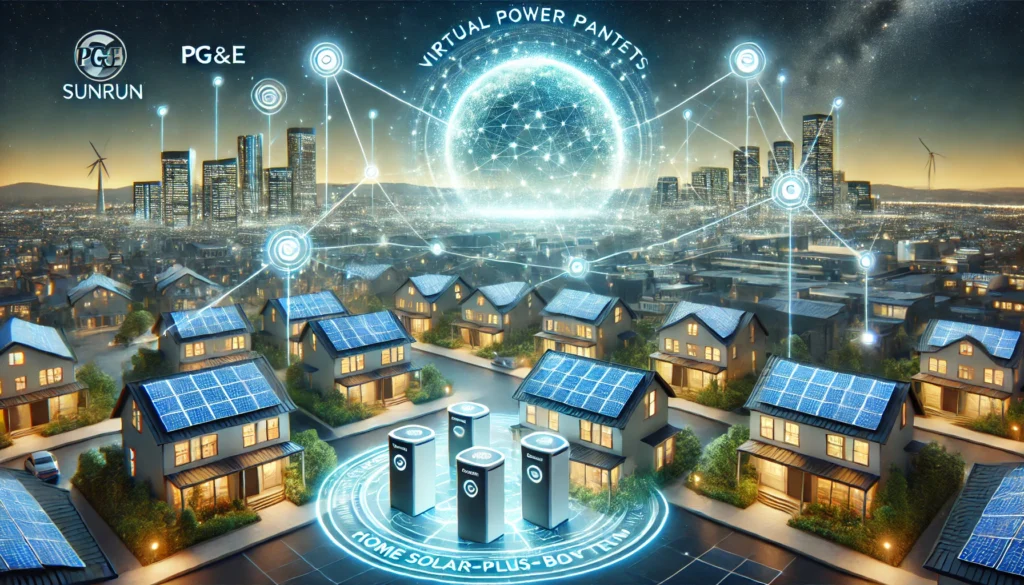Virtual Power Plants Go Mainstream: What PG&E & Sunrun’s New Program Reveals About the Future‑Proof Value of a Home Solar‑Plus‑Battery System
On April 2, 2025, Pacific Gas & Electric (PG&E) made headlines by announcing $43 million in microgrid resilience grants and unveiling a groundbreaking partnership with Sunrun: a pilot program called Local PeakShift Power. This initiative will aggregate roughly 600 solar-plus-battery homes into a virtual power plant (VPP)—and each participating homeowner will earn $150 per battery to support the grid during periods of peak demand.
While this might seem like a California story, it’s a clear sign of a larger national trend: utilities are beginning to see homeowners as energy assets, and they’re willing to pay for it. If you have—or are considering—a solar-plus-battery system, this moment represents a major shift in how your home energy investment can benefit both you and the grid.
What Is a Virtual Power Plant (VPP)?
A virtual power plant is a network of distributed energy resources (DERs)—like home solar systems, batteries, smart thermostats, and EV chargers—that are coordinated to act like a single power plant.
Instead of relying solely on large, centralized power stations, utilities can tap into thousands of connected homes to:
✅ Provide power during grid stress
✅ Reduce the need for expensive peaker plants
✅ Stabilize voltage and frequency
✅ Improve energy reliability and resilience
Think of it this way: your home’s battery, when connected to a VPP, doesn’t just power your house—it becomes a miniature energy hub, capable of helping your neighbors and earning you money or credits in the process.
What Makes PG&E and Sunrun’s VPP Pilot So Important?
The Local PeakShift Power program marks one of the most customer-forward utility collaborations in the U.S. Here’s what stands out:
- 💰 Direct homeowner compensation: Participants earn $150 per battery, just for allowing grid access during peak times.
- 🏠 Residential-focused: This isn’t an industrial or commercial program—it’s built around everyday homeowners.
- 🌐 Grid stability with community benefits: By aggregating home storage systems, PG&E can stabilize stressed circuits without building new infrastructure.
- 📈 Scalability: If successful, this model could expand rapidly in other states, giving homeowners more earning opportunities.
It’s a clear message: home batteries are no longer just backup tools—they’re grid resources.
Why Homeowners Should Pay Attention—Even Outside of California
Even if you don’t live in PG&E territory, this pilot program is a blueprint for what’s coming nationwide. More utilities are exploring VPPs as a cost-effective, clean energy solution—and that means more chances for homeowners to earn money and increase energy independence.
States like:
- New York (via ConEd’s Shared Solar and VPP initiatives)
- Texas (ERCOT’s distributed energy pilot programs)
- Vermont (Green Mountain Power’s VPP and battery lease model)
- Arizona and Utah (actively exploring battery incentives and aggregation models)
…are all moving toward similar partnerships, especially as solar and battery adoption increases.
The Financial Case for Solar + Battery Systems Is Stronger Than Ever
Installing a solar-plus-storage system already provides serious benefits:
- 🔋 Energy storage during outages
- 💡 Lower utility bills through time-of-use shifting
- ⚡ Peak demand management for reduced grid reliance
Now, with the rise of VPPs, you can add:
- 💸 Potential earnings from grid services
- 🔌 Participation in utility programs and rebates
- 🌍 Support for a cleaner, more resilient energy system
In short, solar-plus-battery homes are no longer just consumers of energy—they’re becoming active energy producers and contributors, with the financial incentives to match.
The Future Is Flexible, Local, and Powered by You
As VPPs become more mainstream, utilities and regulators are learning to trust and invest in the power of distributed energy—namely, your rooftop solar and your home battery. That means:
- More incentive programs
- More grid participation options
- Greater home energy ROI
Pairing solar panels with a smart battery storage system positions your home not only for energy independence, but for participation in the evolving energy economy.
Final Thoughts: Now’s the Time to Future-Proof Your Energy Setup
The PG&E and Sunrun announcement is more than a pilot—it’s a preview of how millions of American homes will contribute to the energy grid in the coming years. By investing in solar and battery storage now, you’re setting yourself up to:
- 🌞 Save on electricity bills
- 🔋 Keep the lights on during outages
- 💰 Earn income or credits by supporting the grid
- 🌎 Help accelerate the shift to clean, local energy
Want to learn how to build a solar-plus-storage system that’s VPP-ready? Contact us today for a custom consultation and let us help you design a solution that saves money now and prepares your home for the energy future.
Ready to make the switch?
Contact us today to learn how solar panels can help you save more in the long run!
Complete Residential Solar Panels and Systems. Serving Texas, Oklahoma, Kansas, Missouri, Utah, Florida & Ohio
Get a Free Quote Now
